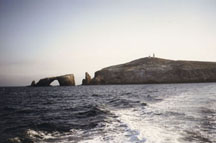
Even before the boat got underway, I knew our day at Anacapa Island was going to be a special one. Mother Nature cooperated beautifully. The Sun shone warmly, the sea sparkled like fine cut crystal, and low swooping gulls seemed to say, "Follow me."
The ninety minute trip out was the sort that would convince a Tennessee farmer to join the merchant marines. Every now and then, a playful sea lion would surface, gliding effortlessly in the water. A pair of huge black whales, free and powerful, rode the waves like giant roller-coaster cars. Fishing boats trawled and crawled by.
At last, the mainland faded and the islands came softly into focus. Anacapa is a rugged chain of three slender islands so closely linked as to form one island five miles long. Visitors are greeted by craggy sheer cliffs, spectacularly inviting but at the same time, forbidding and inaccessible. Yawning rock "mouths", arches, blowholes and surge channels are carved into the island's face, evoking big fantasies in small boys...fantasies of pirate plots and buried treasure.
We explored one of the largest sea caves in a skiff. On some days the cry of the sea lions echoes throughout the caverns as the mammals lounge within.
We landed at Frenchy's Cove, named after the adventurer who lived in a hut on the island until the 1950's. It is the only beach on Anacapa not submerged at high tide.
Declared a National Monument, along with smaller Santa Barbara Island, by President Roosevelt in 1938, Anacapa's untamed beauties are now part of the Channel Islands National Park.
The island's name comes from the Indian term, Eneepah, meaning deception or mirage. The Chumash Indians who originally lived on the islands witnessed strange mirages and distortions when they saw their home from a distance. While we were there, we saw a tanker on the horizon which appeared to be floating in mid-air!
Anacapa is made almost entirely of volcanic rock. And as the island receives little rainfall, the vegetation is scant and desert-like. During spring, however, a yellow sunflower called the giant coreopsis brightens the rocky landscape with its blossoms.
But if the land is semi-barren, the waters surrounding the island are rich and fertile, teeming with marine life. In the tidepools along the southern beach we saw brown and orange starfish of all sizes, dark purple sea urchins and pastel sea anemones...a rainbow of tiny creatures clinging to wet rocks.
Some claim that the waters off Anacapa are among the best in the world for divers. Sea hunters may be rewarded with such delicacies as white and black abalone, scallops, and a variety of fish.
Anacapa is the only nesting place for the brown pelican in all the western United States. Until recently, the birds were an endangered species. In 1969, park rangers found only one new-born pelican in the nesting area. Today, the numbers of pelicans reigning over the 500-foot cliffs of Cat Rock are an especially thrilling sight.
As we continued our tour along the far side of the island, we passed colonies of bellowing sea lions and seals, sunning themselves on the rocky shore. Some even appeared to be posing for camera enthusiasts aboard.
 All too soon, we were passing Arch Rock on East Island.
All too soon, we were passing Arch Rock on East Island.
The rock has become the island's trademark, and as we rounded it and lofty Anacapa Lighthouse, I knew we had to begin our journey home.
But standing on the bow of the boat, sea breezes gently greeted us. We were glad that such an unspoiled, uncommon adventure lay so close to the mainland.

Eleven miles from shore, Anacapa is a good place to take the family, to spend and share the day.
Call (805)642-1393 for further information on this adventurous and unforgettable trip. Click here to visit Island Packers web page.

CLICK HERE for HOME page.
 All too soon, we were passing Arch Rock on East Island.
All too soon, we were passing Arch Rock on East Island.


 All too soon, we were passing Arch Rock on East Island.
All too soon, we were passing Arch Rock on East Island.
